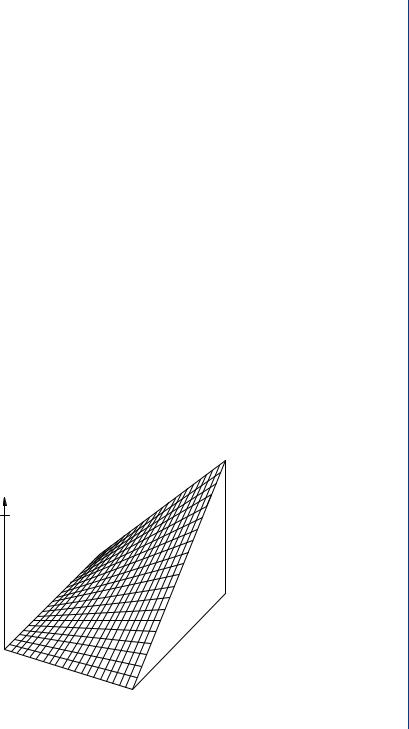
Intermediate Probability Theory for Biomedical Engineers - JohnD. Enderle
.pdf
BIVARIATE RANDOM VARIABLES 43
(c) We find
P (x < y) = |
∞ |
∞ |
|
|
γ |
k |
||||||
|
|
|
|
|
c |
|
|
|
|
λ |
||
|
|
|
|
|
|
|
λ |
|||||
|
k=0 =k+1 |
|
|
|
|
|
|
|||||
|
∞ |
|
|
γ |
k |
|
λk+1 |
|||||
= c |
|
|
|
|
|
|
|
|
|
|
|
|
|
|
|
λ |
|
1 − |
λ |
||||||
|
k=0 |
|
|
|
|
1 |
|
|
||||
= |
c λ |
|
|
|
|
|
|
|
|
|
|
|
1 − λ 1 − λ |
|
|
||||||||||
4.1.2Bivariate Continuous Random Variables
Definition 4.1.5. A bivariate RV (x, y) defined on the probability space (S, , P ) is bivariate continuous if the joint CDF Fx,y is absolutely continuous. To avoid technicalities, we simply note that if Fx,y is absolutely continuous then Fx,y is continuous everywhere and Fx,y is differentiable except perhaps at isolated points. Consequently, there exists a function fx,y satisfying
β |
α |
|
Fx,y (α, β) = |
fx,y (α , β )d α dβ |
(4.20) |
−∞ |
−∞ |
|
The function fx,y is called the bivariate probability density function for the continuous RV (x, y), or simply the joint PDF for the RVs x and y.
Theorem 4.1.4. The joint PDF for the jointly distributed RVs x and y can be determined from the joint CDF as
fx,y (α, β) = |
∂ 2 Fx,y (α, β) |
|
|||
|
|
|
|
|
|
∂β∂ α |
2(h2) 1(h1)Fx,y (α, β) |
|
|
||
|
lim lim |
, |
(4.21) |
||
|
|
||||
= h2→0 h1→0 |
|
h2h1 |
|||
where the limits are taken over positive values of h1 and h2, corresponding to a left-sided derivative in each coordinate.
The univariate, or marginal, PDFs fx and fy may be determined from the joint PDF fx,y as
∞
fx (α) = |
fx,y (α, β) dβ, |
(4.22) |
−∞ |
|
|
and |
|
|
∞ |
|
|
fy (β) = |
fx,y (α, β) d α. |
(4.23) |
−∞ |
|
|

44 INTERMEDIATE PROBABILITY THEORY FOR BIOMEDICAL ENGINEERS
Furthermore, we have |
|
|
|
|
|
|
|
|
|
|
|
|
|
|
|
fx,y (α, β) ≥ 0 |
|
|
|
|
(4.24) |
||||
and |
|
|
|
|
|
|
|
|
|
|
|
|
|
|
∞ ∞ |
fx,y (α, β) d αdβ = 1. |
|
|
|
|
|||||
|
|
−∞ −∞ |
|
|
|
(4.25) |
||||||
|
|
|
|
|
|
|
|
|
|
|
|
|
The probability that (x, y) A may be computed from |
|
|
|
|
|
|
|
|||||
P ((x, y) A) = |
fx,y (α, β)d αdβ. |
(4.26) |
||||||||||
|
|
|
|
(α,β) A |
|
|
|
|
|
|
|
|
This integral represents the volume under the joint PDF surface above the region A. |
|
|||||||||||
Proof. By definition, |
|
|
|
|
|
|
|
|
|
|
|
|
fx ( |
α |
lim |
1(h)Fx,y (α, ∞) |
|
|
|
|
|
|
|||
|
|
|
|
|
|
|
||||||
|
) = h→0 |
|
∞ |
h |
|
|
|
|
|
|
|
|
|
|
lim |
1 |
α |
α , β |
|
α |
|
|
|
||
|
|
|
fx,y ( |
) d |
d |
β |
|
|||||
|
|
h |
|
|||||||||
|
|
= h→0 |
|
|
|
|
|
|||||
−∞ α−h
∞
=fx,y (α, β) dβ.
−∞
The remaining conclusions of the theorem are straightforward consequences of the properties of a joint CDF and the definition of a joint PDF.
We will often refer to the set of points where the joint PDF fx,y is nonzero as the support set for fx,y . For jointly continuous RVs x and y, this support set is often called the support region. Letting Rx,y denote the support region, for any event A we have
P (A) = P (A ∩ Rx,y ). |
(4.27) |
Any function fx,y mapping × to × with a support set Rx,y = Rx × Ry and satisfying
fx,y (α, β) ≥ 0 |
for (almost) all real α and β, |
(4.28) |
fx (α) = |
fx,y (α, β) dβ, |
(4.29) |
|
β Ry |
|

|
BIVARIATE RANDOM VARIABLES 45 |
|
and |
|
|
fy (β) = |
fx,y (α, β) dβ, |
(4.30) |
|
α Rx |
|
where fx and fy are valid one-dimensional PDFs, is a legitimate bivariate PDF.
Theorem 4.1.5. The jointly continuous RVs x and y are independent iff |
|
fx,y (α, β) = fx (α) fy (β) |
(4.31) |
for all real α and β except perhaps at isolated points. |
|
Proof. The theorem follows directly from the definition of joint PDF and independence.
Example 4.1.5. Let A = {(x, y) : −1 < x < 0.5, 0.25 < y < 0.5}, and
fx,y |
(α, β) |
= |
4αβ, |
0 ≤ α ≤ 1, 0 ≤ β ≤ 1 |
|
0, |
otherwise. |
Find: (a) P (A), (b) fx , (c ) fy . (d) Are x and y independent?
Solution. Note that the support region for fx,y is the unit square R = {(α, β) : 0 < α < 1, 0 <
β< 1}. A three-dimensional plot of the PDF is shown in Fig. 4.6.
(a)Since A represents a rectangular region, we can find P (A) from the joint CDF and
(4.27) as
P (A) = P (A ∩ R) = 2(0.5 − 0.25) 1(0.5 − 0)Fx,y (0.5−, 0.5−).
fx,y (a, b)
4
b = 1
a = 0
b = 0
a = 1
FIGURE 4.6: Three-dimensional plot of PDF for Example 4.1.5.

46 INTERMEDIATE PROBABILITY THEORY FOR BIOMEDICAL ENGINEERS
|
|
|
b¢ |
|
|
|
b |
|
|
|
|
|
|
|
|
||
|
|
|
|
|
|
|
a2 |
1 |
1 |
|
|
|
1 |
|
|
|
|
|
|
4 a¢b¢ |
|
|
a2b2 |
b2 |
||
|
|
|
|
|
|
b
0 |
|
|
|
|
0 |
|
|
|
a |
1 a¢ |
1 |
a |
|||||
FIGURE 4.7: PDF and CDF representations for Example 4.1.5.
For 0 ≤ α ≤ 1 and 0 ≤ β ≤ 1 we have
βα
Fx,y (α, β) = 4α β d α dβ = α2β2.
0 0
Substituting, we find
P (A) = 2(0.25)(Fx,y (0.5, 0.5) − Fx,y (0, 0.5))
=Fx,y (0.5, 0.5) − Fx,y (0.5, 0.25)
=643 .
Alternately, using the PDF directly, P (A) is the volume under the PDF curve and above
A:
0.5 0.5
P (A) = 4αβ d αdβ = 643 .
0.25 0
Two-dimensional representations for the PDF and CDF are shown in Fig. 4.7.
(b) We have
|
|
1 |
|
fx (α) = |
0 |
fx,y (α, β)dβ = 2α, 0 ≤ α ≤ 1 |
|
|
|
0, |
otherwise. |
(c) We have |
|
|
|
|
|
1 |
|
fy (β) = |
0 |
fx,y (α, β)dβ = 2α, 0 ≤ α ≤ 1 |
|
|
|
0, |
otherwise. |

BIVARIATE RANDOM VARIABLES 47
(d) Since fx,y (α, β) = fx (α) fy (β) for all real α and β we find that the RVs x and y are
independent. |
|
|
|
|
|
|
|
|
|
|
Example 4.1.6. The jointly distributed RVs x and y have joint PDF |
|
|
||||||||
|
|
|
6(1 − √ |
|
|
), |
0 ≤ α ≤ β ≤ 1 |
|
|
|
fx,y |
(α, β) |
= |
α/β |
|
|
|||||
|
|
0, |
|
|
|
otherwise, |
|
|
||
Find (a) P (A), where A = {(x, y) : 0 < x < 0.5, 0 < y < 0.5}; (b) fx ; (c ) fy , and (d) Fx,y . |
||||||||||
Solution. (a) The support region R for the given PDF is |
|
|
||||||||
|
R = {(α, β) : 0 < α < β < 1}. |
|
|
|||||||
A two-dimensional representation for |
fx,y is shown in Fig. 4.8. Integrating with respect to α |
|||||||||
first, |
|
|
|
|
|
|
|
|
|
|
|
|
|
0.5 |
β |
0.5 |
1 |
||||
|
|
|
|
|
|
|
|
|
||
P (A) = P (A ∩ R) = |
|
6(1 − α/β) d αdβ = 2 β dβ = |
||||||||
|
|
. |
||||||||
|
4 |
|||||||||
|
|
|
0 |
0 |
|
|
|
0 |
|
|
One could integrate with respect to β first:
0.5 0.5
|
|
|
|
P (A) = P (A ∩ R) = |
6(1 − α/β) dβ d α. |
||
0 |
α |
||
This also provides the result—at the expense of a more difficult integration.
b |
|
|
2 |
|
|
6(1 - |
a b ) |
|
0 |
1 |
a |
FIGURE 4.8: PDF representation for Example 4.1.6.

48INTERMEDIATE PROBABILITY THEORY FOR BIOMEDICAL ENGINEERS
(b)For 0 < α < 1,
1 |
|
|
|
) dβ = 6(1 − 2√ |
|
|
||||||
fx (α) = 6(1 − |
|
|
|
+ α). |
||||||||
|
||||||||||||
|
α/β |
α |
||||||||||
α |
|
|
|
|
|
|
|
|
|
|
|
|
(c) For 0 < β < 1, |
|
|
|
|
|
|
|
|
|
|
|
|
β |
|
|
|
|
|
|
|
|
|
|
|
|
|
|
|
|
|
|
|||||||
fy (β) = |
6(1 − |
α/β |
) d α = 2β. |
|||||||||
0 |
|
|
|
|
|
|
|
|
|
|
|
|
(d) For (α, β) Rx,y (i.e., 0 ≤ α ≤ β ≤ 1), |
|
|
|
|
|
|
|
|
|
|
||
|
|
α |
β |
|||||||||
Fx,y (α, β) = 6 |
|
|
|
(1 − |
|
|
) dβ d α |
|||||
|
|
|
α /β |
|||||||||
|
0 |
α |
α |
|||||||||
|
|
|
|
|
|
|
|
|
|
|
|
|
= 6 |
|
|
(β − 2 |
|
+ α ) d α |
|||||||
|
|
α β |
||||||||||
0 √
= 6αβ − 8α αβ + 3α2.
For 0 ≤ β ≤ 1 and β ≤ α,
ββ
Fx,y (α, β) = 6 |
(1 − |
α /β |
) dβ d α |
||
0 |
α |
||||
|
β |
||||
= 6 |
(β − 2 |
|
+ α ) d α |
||
α β |
|||||
0
= β2.
For 0 ≤ α ≤ 1 and β ≥ 1),
|
α |
1 |
|
|
|
|
|
Fx,y (α, β) = 6 |
|
(1 − |
|
) dβ d α |
|
||
|
α /β |
|
|||||
|
0 |
α |
|
||||
|
α |
|
|
|
|
|
|
= 6 |
(1 − 2√ |
|
+ α ) d α |
|
|||
α |
|
||||||
|
0 |
|
|
|
|
|
|
= 6α − 8α3/2 + 3α2. |
|
||||||

BIVARIATE RANDOM VARIABLES 49
4.1.3Bivariate Mixed Random Variables
Definition 4.1.6. The bivariate RV (x, y) defined on the probability space (S, , P ) is a mixed RV if it is neither discrete nor continuous.
Unlike the one-dimensional case, where the Lebesgue Decomposition Theorem enables us to separate a univariate CDF into discrete and continuous parts, the bivariate case requires either the two-dimensional Riemann-Stieltjes integral or the use of Dirac delta functions along with the two-dimensional Riemann integral. We illustrate the use of Dirac delta functions below. The two-dimensional Riemann-Stieltjes integral is treated in the following section. The probability that (x, y) A can be expressed as
P ((x, y) A) = |
(α,β) A |
dFx,y (α, β) = |
dFx,y (α, β). |
(4.32) |
||||||
|
|
|
|
|
A |
|
|
|
||
Example 4.1.7. The RVs x and y have joint CDF |
|
|
|
|
|
|||||
|
|
|
0, |
|
α < 0 |
|
|
|
|
|
|
|
|
0, |
|
β < 0 |
|
|
|
|
|
Fx,y |
(α, β) |
= |
αβ/4, |
0 ≤ α < 1, |
0 ≤ β < 2 |
|
||||
|
β/ |
, |
1 ≤ |
α, |
0 ≤ |
β < |
2 |
|
||
|
|
|
4 |
|
|
|
|
|||
|
|
|
α/2, 0 ≤ α < 1, |
2 ≤ β |
|
|
||||
|
|
|
1, |
|
1 ≤ α, |
2 ≤ β. |
|
|
||
(a) Find an expression for Fx,y using unit-step functions. (b) Find Fx and Fy . Are x and y independent? (c) Find fx , fy , and fx,y (using Dirac delta functions). (d) Evaluate
∞β
I = fx (α) fy (β) d αdβ.
−∞ −∞
(e) Find P (x ≤ y).
Solution. (a) A two-dimensional representation for the given CDF is illustrated in Fig. 4.9. This figure is useful for obtaining the CDF representation in terms of unit step functions. Using the figure, the given CDF can be expressed as
1
Fx,y (α, β) = 4 (u(α) − u(α − 1))(αβu(β) + (2α − αβ)u(β − 2)) + 14 u(α − 1)(βu(β) + (4 − β)u(β − 2)).

50 INTERMEDIATE PROBABILITY THEORY FOR BIOMEDICAL ENGINEERS
|
|
|
b |
|
|
|
|
|
||||
|
|
|
|
|
|
|
||||||
|
|
|
|
|
a |
|
|
1 |
|
|
||
|
|
|
2 |
|
|
|
|
|
|
|||
|
|
|
|
|
|
|
|
|
||||
2 |
|
|
|
|
|
|
|
|
|
|
|
|
|
|
|
ab |
|
|
b |
||||||
1 |
|
|
|
|
|
|||||||
|
|
|
4 |
|
|
|
|
4 |
|
|
||
|
|
|
|
|
|
|
|
|||||
0 |
|
|
|
|
|
|
|
|
|
|
|
|
|
|
|
|
|
|
|
1 |
|
a |
|
||
FIGURE 4.9: CDF representation for Example 4.1.7.
(b) The marginal CDFs are found as |
|
|
|
|
|
|
|
|
Fx (α) = Fx,y (α, ∞) = |
|
α |
|
α |
|
|||
|
|
|
u(α) + |
1 − |
|
|
u(α − 1) |
|
|
2 |
2 |
||||||
and |
|
|
|
|
|
|
|
|
|
β |
|
β |
|
||||
Fy (β) = Fx,y (∞, β) = |
|
u(β) + |
1 − |
|
u(β − 2). |
|||
4 |
4 |
|||||||
Since Fx,y (0.5, 0.5) = 1/16 = 1/32 = Fx (0.5)Fy (0.5), we conclude that x and y are not independent. (c) Differentiating, we find
fx (α) = 0.5(u(α) − u(α − 1)) + 0.5δ(α − 1)
and
fy (β) = 0.25(u(β) − u(β − 2)) + 0.5δ(β − 2).
Partial differentiation of Fx,y (α, β) with respect to α and β yields
fx,y (α, β) = 0.25(u(α) − u(α − 1))(u(β) − u(β − 2)) + 0.5δ(α − 1)δ(β − 2).
This differentiation result can of course be obtained using the product rule and using u(1)(α) = δ(α). An easier way is to use the two-dimensional representation of Fig. 4.9. Inside any of the indicated regions, the CDF is easily differentiated. If there is a jump along the boundary, then there is a Dirac delta function in the variable which changes to move across the boundary. An examination of Fig. 4.9 reveals a jump of 0.5 along β = 2, 1 ≤ α. Another jump of height 0.5 occurs along α = 1, 2 ≤ β. Since errors are always easily made, it is always worthwhile to check the result by integrating the resulting PDF to ensure the total volume under the PDF is one.

BIVARIATE RANDOM VARIABLES 51
(d) The given integral is
|
|
|
|
|
|
|
|
|
|
|
|
|
∞ |
|
|
|
|
|
|
|
|
|
|
|
|
|
|
|
|
|
|
|
|
|
|
|
|
|
|
|
|
|
|
|
|
I = Fx (β) fy (β) dβ. |
|
|
|
|
|||||||||||||||||||||||
|
|
|
|
|
|
|
|
|
|
|
−∞ |
|
|
|
|
|
|
|
|
|
|
|
|
|
|
|
|
|
|
|
|
|
|
|||
Substituting, we find |
|
|
|
|
|
|
|
|
|
|
|
|
|
|
|
|
|
|
|
|
|
|
|
|
|
|
|
|
|
|
|
|
|
|
|
|
|
1 |
|
β |
1 |
|
|
|
|
|
|
|
|
|
|
|
|
|
|
|
|
1 |
|
|
|
|
|
|
|
||||||||
I = |
|
|
(u(β) − u(β |
− 2)) + |
δ(β − 2) |
dβ |
|
|
||||||||||||||||||||||||||||
|
|
|
|
|
|
|
|
|
|
|
|
|
|
|
||||||||||||||||||||||
2 |
|
4 |
2 |
|
|
|||||||||||||||||||||||||||||||
|
0 |
∞ |
|
|
|
|
|
|
|
|
|
|
|
|
|
|
|
|
|
|
|
|
|
|
|
|
|
|
|
|
|
|
|
|||
|
|
1 |
|
|
|
|
|
|
|
|
|
|
|
|
|
|
|
|
|
1 |
|
|
|
|
|
|
|
|||||||||
|
|
|
|
|
|
|
|
|
|
|
|
|
|
|
|
|
|
|
|
|
|
|
|
|
|
|
|
|
|
|||||||
|
+ |
|
|
|
|
|
(u(β) − u(β |
− 2)) + |
|
|
|
δ(β − 2) |
|
dβ |
|
|
||||||||||||||||||||
|
|
|
|
4 |
2 |
|
|
|
||||||||||||||||||||||||||||
|
1 |
|
|
|
|
|
|
|
|
|
|
|
|
|
|
|
|
|
|
|
|
|
|
|
|
|
|
|
|
|
|
|
|
|
|
|
|
1 |
|
|
|
|
|
|
|
|
2 |
|
|
|
1 |
|
|
13 |
|
|
|
|
|
|
|
|
|
|
|||||||||
|
β |
|
|
|
|
1 |
|
|
|
|
|
|
|
|
|
|
|
|
|
|||||||||||||||||
= |
|
|
dβ + |
|
|
|
|
dβ |
+ |
|
|
|
= |
|
|
|
|
. |
|
|
|
|
|
|
|
|
||||||||||
0 |
8 |
1 |
4 |
2 |
16 |
|
|
|
|
|
|
|
|
|||||||||||||||||||||||
|
|
|
|
|
|
|
|
|
|
|
|
|
|
|
|
|
|
|
|
|
|
|
|
|
|
|
|
|
|
|
|
|
|
|||
(e) We have |
|
|
|
|
|
|
|
|
|
|
|
|
|
|
|
|
|
|
|
|
|
|
|
|
|
|
|
|
|
|
|
|
|
|
|
|
|
|
|
|
|
|
|
|
|
|
|
|
|
|
∞ |
β |
|
|
|
|
|
|
|
|
|
|
|
|
|
|
|
|
|
|
|
|
|
|
|
|
|
|
|
|
|
|
|
|
|
|
|
|
|
|
|
|
|
|
|
|
|
|
|
|
|
|
|
|
|
|
|
|
|
|
|
P (x ≤ y) = |
|
fx,y (α, β) d α dβ. |
|
|
|
|
|||||||||||||||||||||||||||||
|
|
|
|
|
|
|
|
|
|
|
|
−∞ −∞ |
|
|
|
|
|
|
|
|
|
|
|
|
|
|
|
|
|
|
|
|
|
|||
Substituting, |
|
|
|
|
|
|
|
|
|
|
|
|
|
|
|
|
|
|
|
|
|
|
|
|
|
|
|
|
|
|
|
|
|
|
|
|
|
|
|
|
|
|
1 |
|
β |
1 |
|
|
|
|
|
|
|
|
2 |
1 |
|
|
|
|
|
|
|
|
|
1 |
|
7 |
|
||||
P (x ≤ y) = |
|
|
|
|
d α dβ + |
|
|
1 |
d α dβ + |
= |
. |
|||||||||||||||||||||||||
|
|
|
|
|
4 |
|
|
|
|
4 |
2 |
8 |
||||||||||||||||||||||||
|
0 |
|
|
|
0 |
|
|
|
|
|
|
1 |
0 |
|
|
|
|
|
|
|
|
|
|
|
|
|
|
|
||||||||
As an alternative, P (x ≤ y) = 1 − P (x > y), with |
|
|
|
|
|
|
|
|
|
|
|
|
|
|
|
|
|
|||||||||||||||||||
|
|
|
|
|
|
|
|
|
|
1 |
|
α |
|
|
|
|
|
1 |
|
|
|
|
|
|||||||||||||
|
|
|
P (x > y) = |
|
1 |
|
|
|
|
|
|
|
|
|
||||||||||||||||||||||
|
|
|
|
|
|
|
dβd α = |
|
. |
|
|
|
|
|||||||||||||||||||||||
|
|
|
|
|
|
4 |
8 |
|
|
|
|
|||||||||||||||||||||||||
|
|
|
|
|
|
|
|
|
|
0 |
0 |
|
|
|
|
|
|
|
|
|
|
|
|
|
|
|
|
|
|
|
|
|||||
Drill Problem 4.1.1. Consider the experiment of tossing a fair coin three times. Let the random variable x denote the total number of heads and the random variable y denote the difference between the number of heads and tails resulting from the experiment. Determine: (a) px,y (3, 3), (b) px,y (1, −1), (c ) px,y (2, 1), (d ) px,y (0, −3), (e )Fx,y (0, 0), ( f )Fx,y (1, 8), (g )Fx,y (2, 1), and (h) Fx,y (3, 3).
Answers: 1/8, 3/8, 1/8, 3/8, 1, 1/2, 7/8, 1/8.

52 INTERMEDIATE PROBABILITY THEORY FOR BIOMEDICAL ENGINEERS
Drill Problem 4.1.2. The RVs x and y have joint PMF specified in the table below.
αβ px,y (α, β)
0 |
1 |
1/8 |
1 |
1 |
1/8 |
1 |
2 |
2/8 |
1 |
3 |
1/8 |
2 |
2 |
1/8 |
2 |
3 |
1/8 |
3 |
3 |
1/8 |
Determine: (a) px (1), (b) py (2), (c ) px (2), (d ) px (3).
Answers: 1/8, 1/4, 1/2, 3/8.
Drill Problem 4.1.3. Consider the experiment of tossing a fair tetrahedral die (with faces labeled 0,1,2,3) twice. Let x be a RV equaling the sum of the numbers tossed, and let y be a RV equaling the absolute value of the difference of the numbers tossed. Find: (a) Fy (0), (b)Fy (2), (c ) py (2), (d ) py (3).
Answers: 1/4, 14/16, 4/16, 2/16.
Drill Problem 4.1.4. The joint PDF for the RVs x and y is
fx,y (α, β) = 2 |
β |
, |
0 |
< β |
≤ |
√ |
|
< |
1 |
|
α |
||||||||||
α |
||||||||||
|
|
|
|
|
||||||
0, |
|
|
elsewhere. |
|
||||||
Find: (a) fx (0.25), (b) fy (0.25), (c) whether or not x and y are independent random variables.
Answers: 1, ln (4), no.
Drill Problem 4.1.5. With the joint PDF of random variables x and y given by
fx,y |
(α, β) |
= |
aα2β, 0 ≤ α ≤ 3, 0 ≤ β ≤ 1 |
|
|
0, |
otherwise, |
||
where a is a constant, determine: (a) a, (b)P (0 ≤ x ≤ 1, 0 ≤ y ≤ 1/2), (c )P (xy ≤ 1), (d )P (x + y ≤ 1).
Answers: 1/108, 7/27, 2/9, 1/270.
